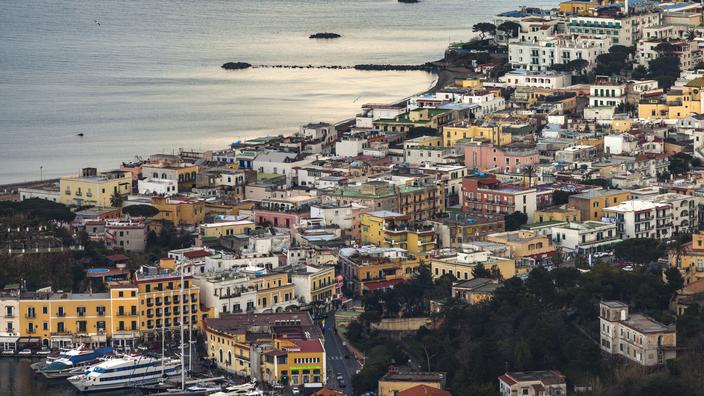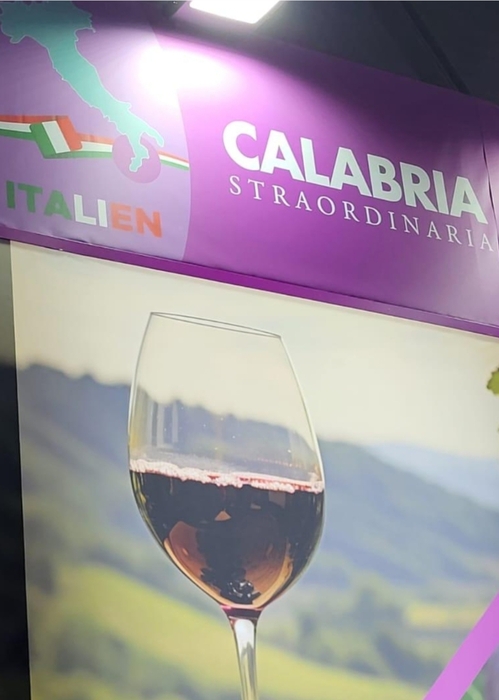Next to the great Ischia, Capri is tiny (10 km2 against 46).
The first is volcanic with a rich thermal heritage.
The second is limestone with caves and rocks emerging from the sea. Both islands are mountainous: Capri is covered with Mediterranean scrub, when Ischia is home to lush vegetation and numerous forests.
Located almost equidistant from Naples, they are each easily accessible by ferry in one to two hours.
But Ischia is in the North while Capri is in the South, facing the Sorrento Peninsula.
A few tips to help you choose your island.
To discover
Partner stay: "The Italian lakes, the great enchanting sites"
Read also: Southern Italy: four ideas for an island and solar escape
Rather cave or volcano?
Breakthrough of many cavities, Capri is home to the famous Grotta Azzura, an underwater chasm located in the northwest of the island whose cobalt blue reflections seem almost fluorescent. Capri Tourist Office
In
Capri
, caves and cliffs are part of the landscape. Formerly linked to the Sorrentine peninsula, the mythical island is the only one in the Gulf of Naples that is not volcanic. Pierced by numerous cavities, Capri is home to the famous Grotta Azzura (blue cave), an underwater chasm located in the northwest of the island whose cobalt blue reflections seem almost fluorescent. But there are many other caves in Capri. To discover them, the ideal is to go around the island in Gozzo, a traditional fishing boat, the opportunity to admire the many rocks that stand in the sea. The most famous are the Faraglioni, three majestic peaks limestones detached from the island by erosion, unfortunately threatened by dynamite fishing.
Also
worth
seeing:
the Grotta Verde, located southwest of Capri, not far from Punta Ventroso.
Less famous than its big sister the Grotta Azzura, it offers magnificent emerald reflections.
Read also: Travel to Italy: certificate, end of quarantine… What you need to know for this summer
In
Ischia
, the thermal springs have been famous since ancient times. The Romans were the first to use them to build public baths like the one near the Nitrodi spring in Barano d'Ischia. Today, there are more than 100 springs and nearly 70 groups of fumaroles spread over the island. If there is one thing to do in Ischia, it is to spend a day in a thermal establishment to take advantage of the swimming pools, generally immersed in an exuberant nature. With around twenty pools, the temperature of which is between 16 ° and 40 ° C, the Poseidon Gardens, located in the bay of Citara near Forio, have been a benchmark since the 1960s. Count around € 32 for the day.
To see also:
the bay of Sorgeto, at the southern tip of Ischia, where warm waters spring below sea level, is the ideal spot for swimming all year round, even in winter.
Who gets the best view?
From the summit of Monte Solaro you can see all the way to Calabria in the south and to the Pontine Islands in the north.
Beata Milewska / Adobe Stock
Capri
is dominated by Monte Solaro, which rises 589 m above the hazy blue waters of the Tyrrhenian Sea. From the summit you can see as far as Calabria in the south and as far as the Pontine Islands in the north near Rome, without forgetting the Gulf of Naples… The slopes of Monte Solaro are covered with endemic wild flowers, such as Erba Cetra, a kind of local lemon balm. A chairlift from piazza Vittoria reaches the summit, brushing against the pines (from € 9 one way). The more athletic will take the mule track and visit the charming hermitage of Cetrella.
Also to see:
Via Krupp, designed by the Kaiser's cannon maker to descend from his villa perched on the rocks of the Sirens of Marina Piccola.
The panoramas of this corniche road (pedestrian) are legendary.
The view from Monte Epomeo, which rises to almost 800 m.
Massimo Buonaiuto / Adobe Stock
Ischia is
home to Monte Epomeo, the emerged part of a vast underwater volcanic complex attached to the Phlegraean Fields. Culminating at almost 800 m, this extinct volcano is accessible in 1 hour of hiking from the village of Serrara Fontana, itself located at more than 350 m of altitude. Several trails start from the village square, crossing ancient lava flows bordered by lush undergrowth and fragrant Mediterranean scrub. Once at the top, the panorama over the Gulf of Naples is magnificent. The must: enjoy a pasta on the terrace of the small “altitude” restaurant, the Grotta da Fiore.
Also worth seeing
:
the coastal path to Ischia Ponte.
Overlooking the sea, it passes through the vineyards of Biancolella and Forestera, as well as cellars carved into the volcanic rocks.
Glamorous or confidential atmosphere?
In the south-west of the island, linked by an isthmus, Sant'Angelo, a charming fishing village.
Tommaso Lizzul / Adobe Stock
Augustus was the first to come to
Capri
but it was with Tiberius, who built the spectacular Villa Jovis on a promontory in the east of the island, that it became the haunt of the Roman nobility. Since Antiquity, Capri has fascinated and attracted celebrities. You can't miss its famous Piazzetta ("little square") when you get out of the ferry. This charming rectangle of a few square meters became the "living room of the world" at the time when Jackie O. and Sophia Loren, just disembarked from a yacht, came there for a drink, almost incognito. Today, the “Chiazza”, as the Capresi call it, is invaded by terraces where you have to see and be seen. To enjoy it without the flood of tourists, have a coffee there before 10 a.m. or escape in winter when the bars have tidied up their terraces and cold but clear air floats over the island.
Also worth seeing:
the little alleys just above Piazzetta, taking the stairs that go up to the cathedral. The silence and peace that reign there seem light years away from the confusion of the famous square.
In
Ischia
, the villages are much more numerous. If only one had to be chosen, it would be Sant'Angelo in the southwest of the island. Connected by an isthmus, this charming fishing village, entirely pedestrianized, has become the chic destination of Ischia. Its colorful houses clinging to the rock facing the Mediterranean have not changed since the 1950s. Only a few luxury hotels have come to settle discreetly. Sant'Angelo also has his Piazzetta. Less known than that of Capri but just as charming, it can be crowded in summer. The German Chancellor would have her habits there.
Also
worth
seeing
:
the upper part of Sant'Angelo, called “la Madonnella”, where the pretty church of San Michele Arcangelo, the patron saint of the village, is located.
The panoramas on the fishermen's houses and the sea are enchanting.
Rocky cove or sandy beach?
The most famous beaches of Capri are those of Marina Piccola, protected from the wind by Monte Solaro.
Capri Tourist Office
Capri
does not have sandy beaches.
Rather landscaped rocks or small pebble beaches which are accessed by steep paths or steep staircases.
In short, the crystalline sea that we admire from all sides must be earned.
The largest beach on the island is Marina Grande, close to the port but bathed in turquoise water, while the most famous are Marina Piccola, protected from the wind by Monte Solaro.
As for the Capresi, many prefer the rock of the Punta Carena lighthouse, in Anacapri, where you can admire the sun going down into the sea and enjoy its last rays.
Also to see:
to swim in front of the famous Faraglioni, take the water taxis from Marina Piccola to one of the 2 private beaches of Punta Tragara.
Read also: Head for Procida, the mysterious island off the coast of Naples
Protected by majestic hills, surrounded by steep cliffs and benefiting from turquoise water, the Maronti beach stretches over 3km of volcanic sand.
EugeS / stock.adobe.com
Ischia has
no shortage of beaches, between its long bays and its jagged coves. That of San Montano, near the village of Lacco Ameno, is undoubtedly one of the most attractive, a half-moon framed by rocks covered with fine sand. In Forio, Citara beach, facing due west, is famous for its transparent water. But the most beautiful is that of the Maronti, accessible by taxi boat from the village of Sant'Angelo. Protected by majestic hills, surrounded by steep cliffs and benefiting from turquoise water, it stretches over 3 km of volcanic sand with medicinal properties.
To see also:
the thermal baths of Cavascura, fed by the most powerful source of Ischia, located 300 m from Maronti beach, for a mud bath as under the Roman Empire.
From 12 €.
Cinema decor or literary stroll?
Capri (here, the famous Faraglioni limestone peaks) has inspired Alexandre Dumas, Henry James as well as Alberto Moravia for
Le Mépris.
ronnybas / stock.adobe.com
Capri
is a romantic island, where Grand Tour travelers came to seek inspiration in the 19th century.
Alexandre Dumas, Henry James, Curzio Malaparte and many others were dazzled by its blinding light and majestic rocks emerging from the water.
Lover of Capri, Alberto Moravia set one of his famous novels there,
Le Mépris
, adapted for the cinema by Jean-Luc Godard.
The scenes in which Brigitte Bardot climbs the stairs of the Villa Malaparte, a Pompeian red vessel hanging on the side of a cliff, are legendary.
To see also:
the magnificent coastal path of Pizzolungo, starting from Piazzetta, which overlooks Villa Malaparte (inaccessible to the visit) and leads to the cave of Matermania, dedicated to the nymphs.
La Villa Malaparte, in Le Mépris by Jean-Luc Godard (1963):
Ischia
inspires happiness and lightness in writers.
Pier Paolo Pasolini reporting on the island describes the feeling of well-being that overwhelms him.
In the comedy
Avanti!
, by Billy Wilder, Jack Lemmon embodies an American industrialist in a hurry whose life is forever turned upside down by his time in Ischia.
The largest island in the Parthenope is also at the heart of the plot of
L'Amie prodigieuse
by Elena Ferrante.
As a teenager, the narrator spent her first vacation in the village of Barano from where she reached the Maronti beach every day.
Also
worth
seeing:
the Colombaia, a neo-Renaissance villa that Luchino Visconti bought after the war. Buried in the vegetation, dominating the coast between Forio and Lacco Ameno, this fascinating residence is today abandoned. The filmmaker rests in the garden.











